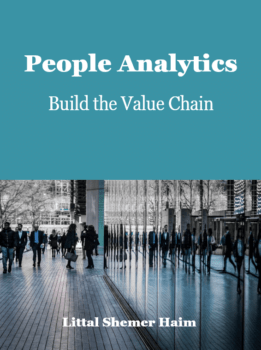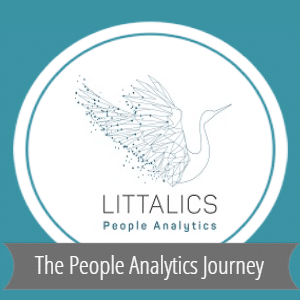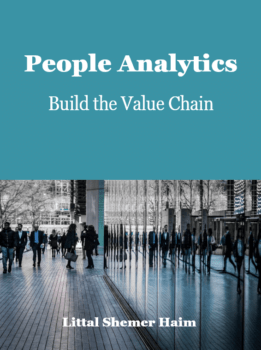(This article is based on my Hebrew “TED” talk at the conference People Geekup Tel Aviv in June 2019. I dedicated this talk to HR professionals who make their first steps on their data-driven journey. Read also my list of Public Speaking).
How to change the analytic mindset of HR for good? I deal with this question for years. I’m a People Analytics consultant and mentor. I help HR teams to leverage people’s data and HR technology to drive insights that contribute to business success. A nice side effect of my activity as an advisor is making HR professionals heroes in their organizations. I’m an applied researcher for more than two decades now – a multidisciplinary professional with a background in Economics, Business Strategy, Psychology, Statistics, Programming, and more. Connecting all dots into a diverse role is not only a millennials theme. It is the reason I started my own business many years ago.
Connecting the dots
Here’s a fun fact about me: I’m a photographer artist. I’m also an eternal student, a curious character who learns about ideas and human experiences, and an autodidact in wide-ranging fields of interest – Positive psychology is one example. A few years ago, I realized that principles of Positive Psychology, which I learned from books and lectures, are nicely reflected in my personal experiences as a photographer artist. I started to document those reflections, and soon enough, I introduced to the world a new therapeutic photography method, that was proved to be effective to my students and audience. I called it Focus on Happiness.
If there a single sentence that sums up my entire therapeutic photography method, this would be it: “The view is an interaction of ability and opportunity”. Every picture or frame of our lives is a combination of the things we can do and the circumstances that enable us to do so. As simple as that. This insight is most relevant for me today, as I mentor HR managers on their data-driven journey. The impact of HR professionals in their organization is a combination of what they can do with data, and the business needs, i.e., the circumstances in which they express this ability. Today I’ll share the three key practices (and a bonus one too) that enable such a combination, between ability and opportunity. If HR professionals follow them, their success in impacting the business by People Analytics is guaranteed.
Computers are useless
Why not start with the bonus, for a change? The first quote I added to my diverse inspiration list has been attributed to Pablo Picasso, the most vital artist of the 20th century: “Computers Are Useless. They Can Only Give You Answers”. Obviously, Picasso had no clue about People Analytics, but his idea is applicable to all of us in this domain. There is no point in running the most sophisticated analytics or building a shiny dashboard, without the attempt to answer a business question. Start your analytical journey with a business question that involves actionable insights. Picasso was right! Computers can only give us answers. We are the ones who must come up with the right business questions in the first place. Only then, we can proceed with the data, our people data.
Experiment with data – our own data
In my recent article, People Analytics – Build the Value Chain, I mentioned that there are plenty of online courses for People Analytics. Some are pretty good; others are nothing but excellent because they enable students to be exposed to the invaluable experience of experts, respected colleagues in this field. However, all online courses lack the opportunity to exercise actual business questions of your company and real people data from your own HR-tech solutions. This can be done only in Intra-organizational training and mentoring. Such training enables up-skilling HR to be more data-driven, and moreover, it may also be the actual foundation of People Analytics projects.
So, whatever you do to educate yourselves, make sure that your learning opportunities include experiments with your own data. Master business questions in your organization and your own data, so you’ll be able to build your company HR data strategy in the near future – move from business question to actionable insights by owning your data sources, storages, analytics and visualized outputs.
Hack #1 – when you afraid to fail
I was recently a panelist in HackingHR Tel Aviv. For me, the most exciting moment in the event was when half of the audience raised hands after I asked, “Who works today or is going to start working soon in People Analytics?” I knew most of those faces in the audience, and I realize my contribution to establishing this profession in my country. But it doesn’t mean I didn’t fail. And personally, I know a lot about the fear of failure.
When you start your journey to data-driven HR, be prepared to fail. However, if you create psychological safety in your learning environment, you won’t be afraid to start again. Your failure will only mean that you are not there, yet, but you are getting there. Take Adam Grant’s advice – always question your default solutions and try other options. Or, in the word of a mentee testimonial, in a case study of people Analytics is SMBs – “We could afford to experiment with data, and making mistakes, knowing that we had the support of a professional framework… In our mentoring sessions, but also between sessions, each of us could comfortably ask any question, raise ideas, and make a mistake. Thanks to the openness that was created within the team, everybody felt that we were able to cope with the challenge.”
Hack #2 – when change is difficult
Change is inevitable, and that is also true in the HR domain. But the experience of leading a change is hard. Why? Scientific evidence connect the challenge of change to the way the human brain is wired and explains why most change initiatives fail. As I previously mentioned, “A core driver of the brain function is maintaining safety and stability. Therefore, even a beneficial change can be perceived as a threat. When you lead a change in your organization, you directly conflict with your brains’ core needs.”
To overcome this barrier, and help against the reflexive resistance, you need to create new rituals within learning sessions, that would generate a sense of security. While mentoring HR teams, I discovered that rituals are effective: “When meeting agenda and pace of learning are predictable, and when new social norms such as asking questions and thinking out loud are created, people practice openness and curiosity. Familiarity with the setting gives them a sense of certainty and stability.”
Build the Value Chain
I followed all these key practices – Practice your own data, psychological safety, and rituals – As I built my training program for data-driven HR, which I offer now to organizations worldwide. I help HR professionals to build the People Analytics value chain through sixteen lessons and four milestones. Each HR team can create, with my guidance, its unique rituals. The team members learn by using their own data to solve their business questions, in an experimental environment, where mistakes and failure are welcome as an opportunity to learn. I’m very excited to mold my experience, both my failure and successful case studies, into a structured course that suits each organization, no matter how large or small.
Data Makes you fly
When I started this blog, I chose one of my crane’s photographs for the main page slider. As I previously wrote, cranes are a great metaphor – always on a worldwide journey, with their large flocks, dynamic roles, and inter-dependencies. They are just like us, people in organizations, who are on their journey to data-driven HR. When I wrote on that slider that “data makes you fly”, I couldn’t imagine that in three years I would be recognized as one of the global influencers in the HR-Tech industry, and have such a fascinating career opportunity. In my mind, I only had my career path up to that point. But I also thought about HR leaders who embrace analytics and become heroes in their organizations.
I hope that the HR journey in the data world will last, as the cranes’ endless journey. However, we face such dramatic change now, that may turn everything to other directions. The demand for new skills in the HR role, i.e., the Procurement and Ethics of HR-Tech breathe down our neck. HR people can’t procrastinate their own change. They must up-skill and be more data-driven. I call you to join this journey today.
Featured in the book

"You will find in this book sixteen lessons, organized in four milestones that, from my experience, build the People Analytics value chain."
Subscribe to the weekly newsletter to receive more featured samples and pre-order opportunities









2 thoughts on “Changing the Analytic Mindset of HR for Good”
This blog post really resonated with me. So often I’ve experienced business leaders requesting dashboards and analytics only to find out later that, once built, they are not being viewed. The use of data to answer business questions and ignite action in an organization is so important to ensure the business is focusing its resources in the right areas in order to continue to propel the business forward. Thanks!
Thank you Adrian!
I’m happy to have this opportunity to explore your blog… 🙂
Comments are closed.